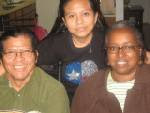MARVELOUS MATH: A BOOK OF POEMS
Bennett, Lee Hopkins. MARVELOUS MATH: A BOOK OF POEMS. New York : Simon & Schuster, 1997.
Math is all around us everywhere. Most people use some form of math each day. Mr. Bennett presents a collection of poems that connect math to every day events in our lives. The poems are written by poets that use various styles (rhyme and free verse, ect.). Ms. Barbour's watercolor illustrations complete the poems with characters dressed in bright colors and silly outfits. Children will enjoy the full pages of common and strange items. It's nice to see more than the use of only numbers.
Marilyn Scala, in our Textbook "Three Voices," stated that math is vocabulary and children need to be taught the concept that math is a language.
Math concepts can be challenging to students who have trouble visualizing the concept. Linking the imagery of poetry to math may help children visualize abstract concepts and operations. (Three Voices) The majority of the poems in MARVELOUS MATH ask children to think about the world without mathematics. One of the keys to understanding what’s important is to view life without it. I liked two of the poems that addressed math concepts.
FRACTIONS
Lee Bennett Hopkins
Broken number pieces
disconnected—
a quarter
a half
an eighth
fragmented—
out of order
out of control—
until—
I explore them
restore them
make them
whole
once more
again.
TIME PASSES
Ilo Orleans
Sixty seconds
Pass in a minute.
Sixty minutes
Pass in an hour.
Twenty-four hours
Pass in a day—
And that’s now TIME
Keeps passing away!
Poetry is a good tool to remove the fear of math and allow children to express how they feel about math even if they don't like math. Children will find math less threatening when the connect with the poems in Marvelous Math.
Review
School Library Journal
Grade 3-5. Hopkins pulls together poems on mathematics, providing insights from writers such as Karla Kuskin, Janet S. Wong, and Lillian M. Fisher. Several selections share the predictable theme of the significance of math and numbers. Rebecca Kai Dotlich's title poem, for example, asks questions such as, "How fast does a New York taxi go?" and "How slow do feathers fall?" and suggests how to find the answers: "Mathematics knows it all!" Some take a unique point of view, as in Betsy Franco's "Math Makes Me Feel Safe": "Knowing that my brother will always be/three years younger than I am,/and every day of the year will have/twenty-four hours." Rhymed and open verse styles are represented, as are a variety of tones. David McCord's "Who Hasn't Played Gazintas?" is a playful presentation of spoken language. Barbour's lively illustrations dance and play around the poems. Her boldly outlined watercolor figures, often wearing ill-fitting hats, fill the pages with childlike whimsy. Children will enjoy studying the oddly colored animals, numbers, and stylized, arched-browed people. A delightful collection
Cullinan, Bernice E. Marilyn C. Scala,, and Virginia
C. Schroder. THREE VOICES: AN INVITATION TO POETRY ACROSS THE CURRICULUM. Portland: Stenhouse Publishers, 1995.
Thursday, March 26, 2009
Subscribe to:
Post Comments (Atom)


No comments:
Post a Comment